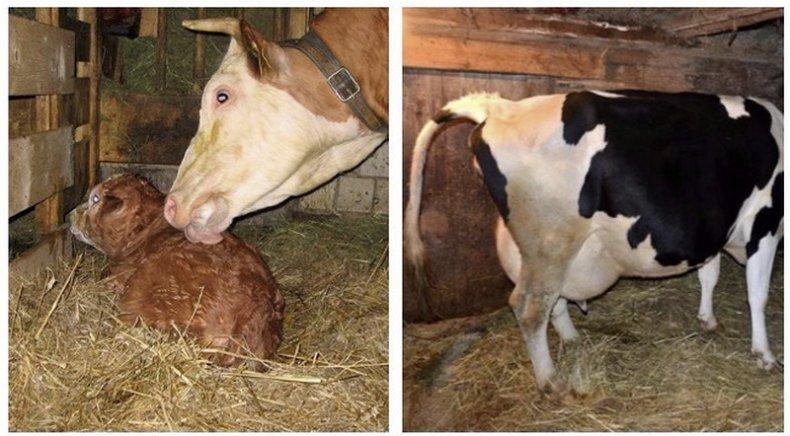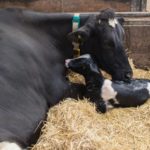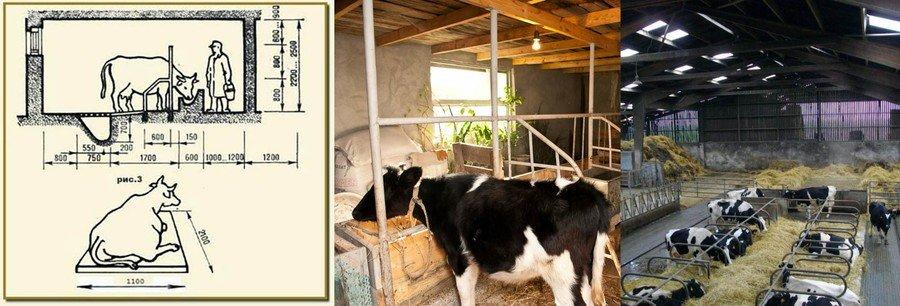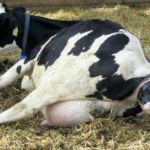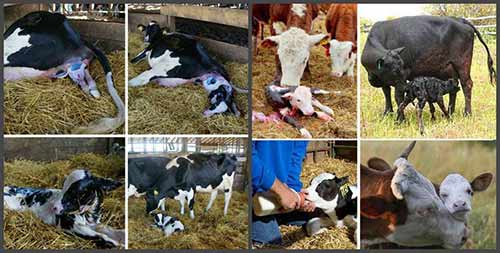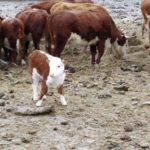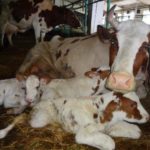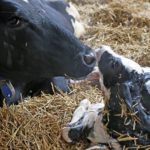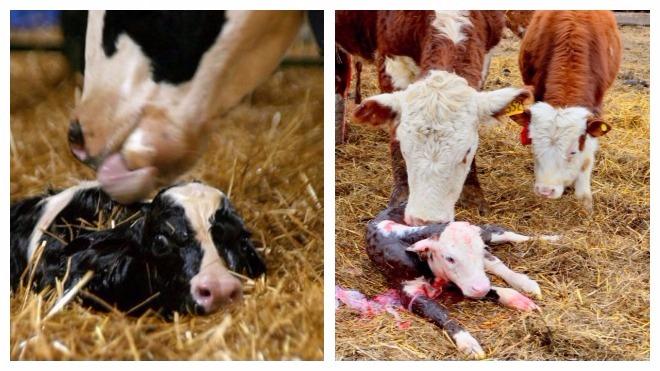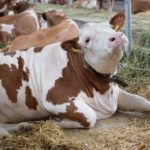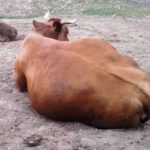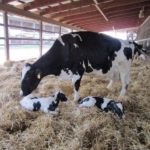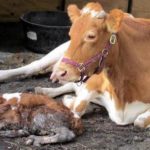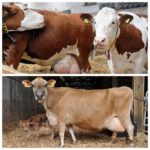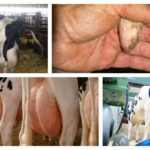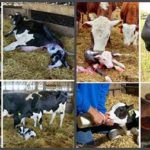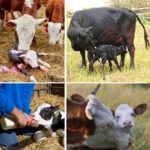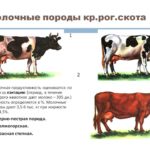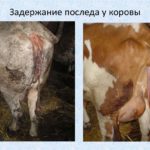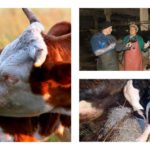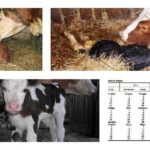Cows produce milk to feed the calf. For lactation to proceed, the cow must calve and give birth to a baby. Therefore, all livestock owners need to know how pregnancy proceeds and how birth (calving) occurs in a cow. Correct behavior of the owner, caring for the animal before and after the birth of the calf will ensure high milk yield, help avoid postpartum problems, and keep the cow and baby healthy.
What is calving?
Pregnant cows are called pregnant (carrying a calf).The natural end of pregnancy is childbirth, which in an animal is called calving. The birth process follows the usual pattern:
- begins with contractions, during which the cervix dilates;
- During pushing, the fetus leaves the body through the birth canal.
You can tell by the cow's behavior that calving is approaching. The animal looks anxious, preparing a place for itself. Contractions last several hours, the period of pushing lasts about an hour. The duration of calving is influenced by many factors:
- the first birth lasts longer than the second one;
- when twins are born, the process is delayed;
- a small fetus comes out faster;
- weakened cows with problems during pregnancy calve longer.
In most cases, cows give birth on their own and do not need assistance. But experienced livestock breeders keep an eye on the woman in labor, tracking the time and characteristics of calving. You should be concerned if calving is delayed:
- in primiparous women it lasts more than 12 hours;
- for other cows – more than 10 hours.
The animal may require the help of a veterinarian; it is better to invite him in advance. In some cows, calving lasts longer, but there are no pathologies; this is within the acceptable limits and is an individual characteristic of the animal.
How the fetus develops
During the intrauterine development of a calf, there is a constant increase in body weight, development of organs and systems. The physiological norm at birth is considered to be a baby’s weight of 30-40 kilograms, for large breeds – 50 kilograms.
Fetal weight gain chart:
| Pregnancy period, month | Fruit length, centimeters | Weight |
| 1 | 1 | 1 gram |
| 2 | 6-7 | 40 grams |
| 3 | 12-14 | 130-150 grams |
| 4 | 22-26 | 2 kilograms |
| 5 | 35-40 | 2.5-4 kilograms |
| 6 | 45-60 | 3.5-6 kilograms |
| 7 | 50-75 | 5-10 |
| 8 | 60-85 | 12-20 |
| 9 | 80-100 | 20-50 kilograms |
The fetus gains most of its weight in the last 2-3 months of pregnancy, the cow’s belly increases before her eyes, and it becomes difficult for her to walk.In first heifers and when twins are pregnant, fetuses may develop more slowly. Calves born in twins often have low weight, they have to be nursed and given milk for longer.
How many days does a cow walk before calving?
A number of factors influence the duration and course of pregnancy. The average period is determined to be 285 days, that is, 9 months. The norm is considered to be a time deviation from these indicators in both directions, that is, 240-311 days.
The duration of pregnancy depends on the following circumstances:
- conditions of detention - feeding, care, starting;
- breed of cow;
- What is the calving period - heifers carry longer.
According to statistics, heifers are born a day or two earlier than bulls. Often the exact date of conception is unknown, so the duration and duration of pregnancy are determined approximately.
Early calving occurs no more often than in 4-6% of cases. The following reasons can provoke early labor:
- poor care;
- large fruit;
- high loads;
- hormonal problems in a cow.
If the pregnancy lasted less than 140 days, the calf is born non-viable and cannot be released. The case is considered a miscarriage.
To determine the deadline calving use calendar, which shows the dates of birth given the known date of insemination and the average duration of pregnancy.
How long can a cow walk?
Prolonged pregnancy is observed in cows in 10% of cases. Burenki move around for various reasons:
- slow fetal development caused by hormonal imbalances;
- characteristics of the body;
- stress.
On large cattle farms, staff specialists regularly monitor pregnant cows. In households, a veterinarian is invited if there is a delay of 10 days. The doctor will examine the animal to identify pathologies.If the pregnancy lasts 311 days or more, urgent specialist intervention is needed to avoid losing the cow and calf.
How to determine calving date
Finding out the date of the expected birth is important for the owner - it is necessary to carry out the launch in a timely manner, in the future this will help to find out whether the cow is over-pacing. To determine the calving time, 2 methods are traditionally used - the above calendar and calculation using the formula.
The calendar table is compiled with a 5-day interval. With its help it is also convenient to determine the timing of the launch.
The date can be determined using the formula:
D=(H+11) (M-3), where
D – day of calving;
H – date of insemination (number);
M – month of mating.
Let's look at how to do the calculations. The cow is covered on September 10 (10.09). H=10, M=9. We insert into the formula: D = (10+11) (9-3), that is, 21.06. June 21 is the expected calving date. If the sum is greater than the possible number of days in a month, subtract 30 and increase the month by 1.
If insemination occurred from January to March, 12 is added to the month number when calculating.
How to understand that a cow is giving birth
The fact that calving will begin soon can be understood by the cow’s behavior and a number of external signs that are harbingers of labor. The room must be prepared in advance, since the formula and table use average pregnancy durations, which in reality may be shorter.
External signs of early calving:
- Relaxed and pliable cord (ligament) under the tail. Relaxation is sometimes observed 2 weeks before birth. Then the cord strengthens, but a few hours before calving it softens again and becomes mobile.
- Swelling, smoothing of the labia.
- The stomach drops noticeably.
- The udder fills up and becomes larger.Colostrum appears from the nipples. A clear, viscous liquid begins to come out 2-3 days before birth, sometimes a few hours after calving.
- The plug covering the cervix begins to dissolve and come out of the vagina 1-2 days before birth. Outwardly, it looks like sticky mucus, tourniquets, leashes hanging down.
- A rectal examination reveals shortening of the cervix.
As birth approaches, the cow becomes fearful, behaves restlessly, fusses, and constantly looks back at her butt. In the pasture, he tries to go to the side and find a secluded place. A stall measuring 3.5x3.5 meters and about 2 meters high is prepared for the animal. All surfaces and sawdust are cleaned in advance and treated with disinfectant solutions.
During a normal birth, the animal does not require assistance. In anticipation of calving soon, the cow is washed with a solution of laundry soap. The mother usually lies on her side, although many animals that give birth many times prefer to calve while standing.
While contractions last, the cow should not be frightened by constant presence or noise. Experienced livestock breeders visit the woman in labor once an hour to monitor the time and progress of calving and understand the need for help.
Contractions become more frequent, the cervix dilates completely, and pushing begins. A bladder appears from the vagina, in it, with its head resting on its front legs, there is a calf. If the bubble does not rupture, it is cut with a sterile instrument.
If the fetus does not come out within half an hour after the water breaks, the cow needs help. The veterinarian also helps if the calf walks on its hind legs or the cow has twins. Within 2 hours after calving, the cow has time to rest; colostrum milked at this time is especially beneficial for the baby.
Rules for caring for a pregnant cow
During the first months of pregnancy, the embryo grows slowly; the cow does not need increased nutrition. The diet is not increased, the emphasis is on completeness and balance. For feeding use:
- roughage - hay, haylage, straw (30-60% of the diet);
- juicy – silage, root crops;
- concentrated - feed, cakes, bran.
Additionally, the following supplements are given daily:
- phosphorus (8 grams);
- calcium (10 grams);
- chalk (50 grams);
- table salt (20-30 grams).
The diet is supplemented with glucose. Frozen and rotten food are excluded. Monitor compliance with the drinking regime, water 2-4 times a day. In winter, the diet is supplemented with pine flour and branches.
Information: a deficiency of vitamins and microelements can cause fetal pathologies and miscarriage.
In the summer, cows are kept on free grazing, choosing places where the animal can hide from the sun. They go to water 2-3 times a day.
2 months before calving, cows are transferred to a dry stand (start-up), succulent and other feeds that stimulate milk production are excluded from the diet. In highly productive breeds, the number of milkings is gradually reduced (brought to 1), in low-productive species, milking is stopped completely.
In the last weeks of pregnancy it is important:
- do not overfeed cows to avoid problems during calving;
- walk up to 3 hours a day so that there are no difficulties during labor;
- monitor the condition of the udder after launch to prevent mastitis.
Underfeeding and overfeeding pregnant cows is equally harmful - this leads to difficult calving and subsequently becomes a cause of barrenness.
Possible problems
The most common hotel problems include:
- Prolongation of labor - within an hour after dilatation of the cervix, the fetus should come out.
- The baby's place (afterbirth) does not come out. The woman in labor is pushing, but the placenta is not expelled. Human help will be required. Then you need to spread out the afterbirth and check its integrity.
- With a breech presentation of the fetus, the woman in labor is helped by pulling the calf by the legs. If the bubble hangs, the animal cannot push the fetus out; the calf is pulled, synchronizing the actions with attempts.
- If there are twins, the veterinarian is called in advance - the calves' legs often get tangled and they won't come out on their own.
During calving, inexperienced livestock breeders need to enlist the support of a veterinarian in advance so that, if necessary, they can urgently call a specialist or consult by telephone.
From how they proceed pregnancy and calving in a cow, the future productivity of the animal and the health of the cow and baby largely depend. Usually calving occurs naturally, but a person must know how to prepare the animal for childbirth and how to help with possible problems.

